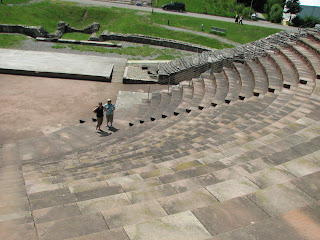AUGUSTA RAURICA-July 9
We were going to go to Lausanne and Geneva after leaving
Langnau. Turns out all the hotels were full in Lausanne—height of the tourist
season and possibly other events going. So, we made a call mid-stream to go
to Basel instead. (That is the beauty of this trip—we have an idea of where we
are going and why but we are making up the details as we go!)
We took the train Monday morning to Basel. Then, after
getting to the hotel, we headed out to explore. The city of Basel goes back a
really long way. Actually, it was not Basel at all. The Romans came in 44 BC
when one of Caesar’s military commanders founded this colony on the Rhine
River. This location was at the intersection of the south-north trade route
from Italy to the Rhineland and east-west from Gaul to the Danube region. The
big river was one of the most important transport routes in the Roman Empire.
Roman troops went north from here and conquered the regions toward
Britain. The city of Augusta Raurica evolved into a regional center with 10,000
to 15,000 citizens.
In the 3rd century, the Romans were forced to
pull back in the face of the encroaching Germanic “barbarians.” (Rome, in fact, was already doomed.) The town was
abandoned quickly; treasures were buried. Later, the Romans built a fort in the
area. In the early Middle Ages, the fort evolved into a settlement. In the 7th
and 8th centuries, Basel, located a little further down the Rhine,
began to rise in power. The once flourishing Roman colonial town of Augusta
Raurica became a small fishing village.
The photos give an idea of the ruins that exist to this day
from the 3rd century city.
In the museum next to the ruins is the largest antique silver collection in the world. This stuff was buried as the Germanic hoards were coming into town.
Just one sample of many platters found among this pile of silver unceremoniously buried and not unearthed until the middle of the 20th century.
The outer wall of the amphitheater.
There has been some restoration on the amphitheater. It is used for concerts today!
It is big enough to hold several thousand people at one time. Here are two for starters.
This would be a fun place to play. It was for these Swiss kids out on holiday.
These are the walls on the back side of the amphitheater--not quite as good shape as the front side.
This is the "curia", the town hall where elected officials sat in judgment on civil matters.
A reinforcing, retainment wall outside the temple mount.
Several intricate mosaics which had been on floors and wall were partially restored. The one above and the one below.
OK . . . so you can see where the sewer starts.
Actually this door goes into the well house at the bath house.

and this is looking up from the bottom of the well!
What I learned today: it is hard to take a photo in a sewer that is two feet wide, five feet high and totally dark. There were a few lights (at each end of the sewer) but in between it was as dark as a . . . sewer. The camera did not know where to focus so I just shot blindly.
It was somehow very cool to walk in the labyrinthine sewer and imagine not only how old it is but the ingenuity required to build it.
These are the outer walls of the fort that was built in the 5th century.
This is the mighty Rhine River that runs through Basel. The old Roman fort is right on the river.
So, everybody needs some gods. These little guys were found in the ruins. Apparently they just weren't quite big enough either to protect the treasure or keep out the invaders.
This is the ceremonial altar to the divine Caesar Augustus. Where do you suppose this guy is today? Being made a god just never seems to work out the way one would think.



















No comments:
Post a Comment